Searching for Consistent Greatness: Running Backs

This off-season, Ryan McDowell and I are doing a joint series (Consistent Greatness/Quality Starts) looking at how well players perform in the games that they played. Check out Ryan’s piece quarterbacks here and my piece on receivers here.
The running back position is the most important in fantasy football, but we are in a time where it is being overlooked and undervalued (in my opinion). With the inconsistency and unreliability from year-to-year, it has become more common for dynasty owners to avoid running backs early while investing at other positions, then ‘punting’ in the later rounds. This approach can be extremely successful and I am a huge supporter of it – providing you don’t pass on great backs early because it is not ‘part of the plan’. The players that are available to you should determine your strategy, but wherever you decide to draft your running backs there are always opportunities to get some veteran steals.
The basis of ‘Consistent Greatness’ is to look at player’s weekly ranks rather than their seasons as a whole. Did most of their points come in one or two big weeks? Or were they good but only provided a low percentage of weeks that could heavily tip the scales in your dynasty team’s favour? I am looking for consistently good with a chance of great.
The Data
I went through every week from 2011-2013 to establish a baseline for the number of points required to place in the top 12 and top 24 at running back each week:
- Points required to be a RB1: 14.3
- Points required to be a RB2: 9.0
I then looked at the weekly totals of the top 50 running backs (based on ADP and excluding 2014 draftees) and tallied all of the times they scored the required points, identifying the best and worst players based on the number of games they have played in throughout their whole careers. The top ten from each category are shown. I left out players from this research that have a top 50 ADP but have not placed in the weekly top 24 at any point in their career so far. These names are:
- Christine Michael
- Marcus Lattimore
- Latavius Murray
- C.J. Anderson
- Khiry Robinson
- Johnathan Franklin
- Robert Turbin
I didn’t manipulate the data based on how many rushes players had, how many catches they made or whether or not they were the starter for the whole game so the data can be interpreted as you wish. We know, for example, that players such as Jamaal Charles and LeSean McCoy spent time behind starters early in their career, so their numbers may be even better if I focused only on the years that they started. I did, however, decide to add some context for comparison by separating the players into two groups. The ‘starters’ are who you will see in most of the piece – featuring players that you expect to start in your fantasy lineup. The second group is the ‘non-starter’ group and includes those players that haven’t really been ‘the guy’ for their teams throughout the majority of their careers. These groups are debatable and changeable (for example, I have included CJ Spiller and Giovani Bernard in the starter group) but the full data will be at the end of the piece so you can put every player up against each other.
I also initially thought about setting a minimum amount of rushes to qualify for a game played, however scoring can be so unique that it would eliminate important weeks that I believe should qualify. For example, in Week 9 of the 2012 season, Marcel Reece had zero rushes but still scored 15.5 fantasy points (eight catches, 95 yards and a touchdown). Therefore, there were no minimum amount of touches to qualify – every game in which a running back played was included.
Key:
- G – Total games since they entered the league
- GP – Number of those games they played in
- RB1 – Number of games they scored 14.3+ points
- RB2 – Number of games they scored between 9.0 and 14.3 points
- RB1/2 – Number of games they scored 9.0+ points
- % – Percentage of games played that they placed in each category
The numbers to focus on when looking at each list are marked in bold.
Note: I used non-PPR scoring and playoff games were not included.
Highest % of Weeks as a RB1/2
[am4show have=’p2;p3;p4;p5;p6;’ guest_error=’sub_message’ user_error=’sub_message’ ]
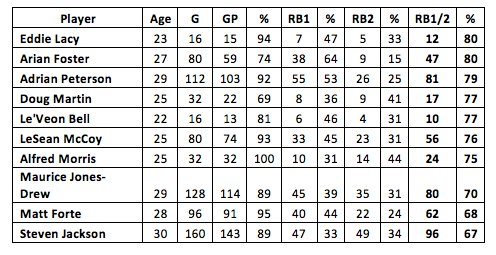
- The 75% and above group is pretty small – only seven players have done it and four of them have only played one or two years in the league. Can they keep it up?
- Eddie Lacy had a fantastic rookie year, but for Adrian Peterson and Arian Foster to sustain the production over such a long period of time is astonishing
- I am buying Foster wherever I can – I fully expect him to keep producing great numbers and even at 27 years old, he has played in fewer games than LeSean McCoy and Jamaal Charles
Lowest % of Weeks as a RB1/2
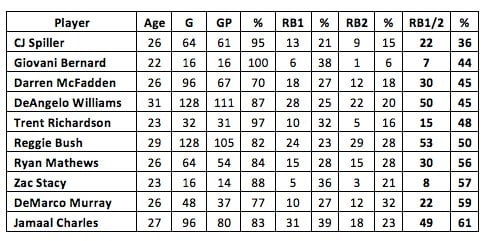
- Will CJ Spiller ever satisfy us and live up to his ADP and potential? He only had six fewer touches in 2013 than his huge 2012 – Can he ever repeat that great year?
- Giovani Bernard is included as a ‘starter’ because I would expect to start him in my lineup but the combination of Benjarvus Green-Ellis and the non-PPR scoring on this list means he scores poorly
- Darren McFadden is often injured and hasn’t scored very well – Is this year his last chance to make an impact?
- Trent Richardson has only scored more than 20 points once in his career (in his second NFL game)
Highest % of Weeks as a RB1
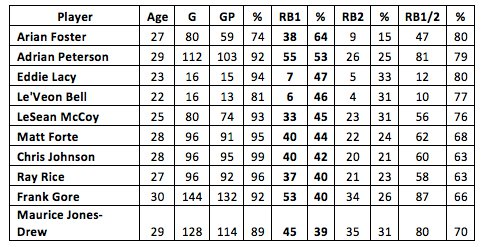
- Foster has accumulated an absurd number of RB1 weeks – In 2012 he scored more than 14.3 points in 13 out of 16 games (crazy)
- Peterson and Foster are the only two players to have finished as RB1s in over half the games they have played
Lowest % of Weeks as a RB1
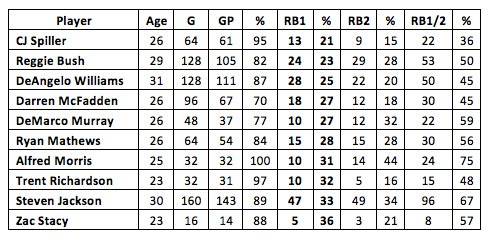
- We know that Spiller, Reggie Bush and DeAngelo Williams have been in and out of starting lineups/job-shares so the percentages will be low
- DeMarco Murray is the RB9 and Ryan Mathews is the RB23 in the July ADP data, yet their numbers are remarkably similar. Can we justify taking Murray 14 spots ahead of Mathews?
Highest % of Weeks as a RB2
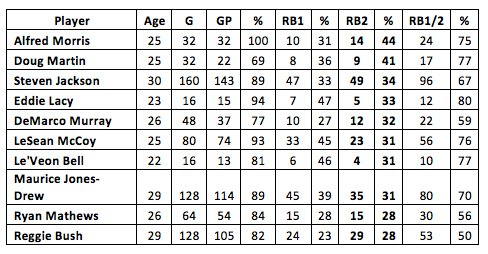
- Alfred Morris comes up big here and similarly to the Murray/Mathews point from earlier – Doug Martin is RB8 and Morris is RB20. Their numbers are alike, so why is Martin 12 spots ahead? I’ll take someone who produces the same, but I can pick up later. However, all of Morris’ big weeks (20+ points) came in 2012 – Does he have a chance of being ‘great?’
Lowest % of Weeks as a RB2
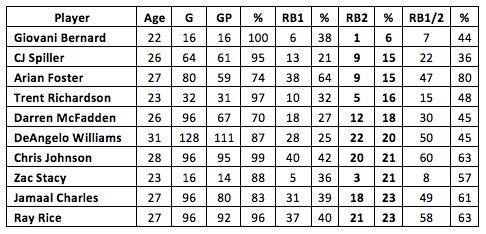
- Unsurprisingly, Gio again tops this list
- Foster is an interesting name in the top three – when he scores, he goes big and exceeds the 14.3 points required to be a RB1. Foster and Spiller are being drafted at RB15 and RB16 yet Foster has had 25 more RB1 weeks than Spiller despite playing in two fewer games.
Most Games Played
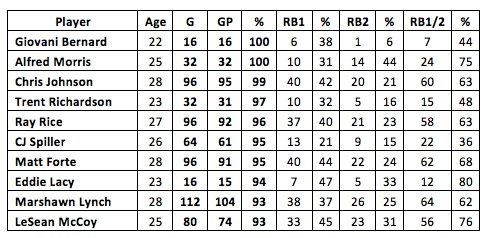
- As well as being undervalued and the undisputed number one back on a strong running team, Morris has also been extremely durable
- Chris Johnson really doesn’t get any love for a player who has had seven straight 1000 yard seasons and whose only game missed was in his rookie year
- Marshawn Lynch’s brutal playing style hasn’t caused him to miss time
Most Games Missed

It is no surprise to see McFadden’s name on this list
- Foster played in six games in 2009 before he burst onto the scene in 2010
- A lot of big names have missed more games than Mathews who sits all the way down at RB23 in the July ADP. He has burned us with injuries before, but at that price, I’m buying
Superstar Weeks
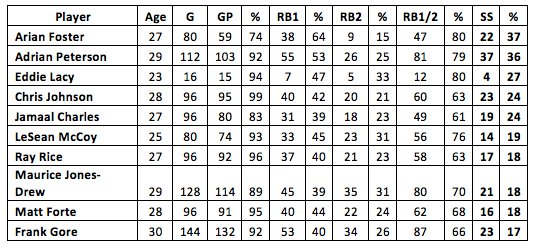
Just like with the receiver data, I felt adding one extra grouping would separate the true stars from the rest. In order to have a ‘superstar week,’ a player must have scored 20 points or more.
(SS refers to the number of games they scored 20+ points)Foster and Peterson are once again on a whole different level
- Johnson and Charles make for an interesting comparison – very similar numbers and Johnson is only one year older
- It is no surprise to see some true great veterans on this list (Maurice Jones-Drew, Matt Forte and Frank Gore). Will their numbers drop this year?
- Does Ray Rice have gas left in the tank at 27 like I believe Foster has?
The Non-Starters

Andre Brown has a ridiculously low games played percentage, but his top 24 stats are up with the starters
- Shane Vereen has missed a lot of games
- Despite the hype, Lamar Miller had zero RB1 weeks last year
- I looked a bit further into three projected starters for 2014 – Montee Ball, Ben Tate and Toby Gerhart by focusing on weeks in which they had ten or more carries. Ball was a RB1/2 50% of the time, Tate 61% and Gerhart 78%. With the workload in Jacksonville, Gerhart will get a chance to prove he can sustain that percentage and if he does; you had better buy him now.
What can we take from this?
All of the research carried out is based on historical data. We don’t know what the future holds for any of these players, but a deeper understanding of how they scored their points and performed in the past can help us look ahead. Any time you learn something about a player, it should force you to re-think and re-consider what you know. After doing this research I am buying Arian Foster wherever I can as I believe a huge bounce-back season is on the cards. I will happily draft/trade for Alfred Morris and Ryan Mathews at their current prices and have no problem snapping up Chris Johnson and Ray Rice at veteran discounts. Of course, we must continue to search for the next breakout stars, but grabbing undervalued veterans is an important part of dynasty success – embrace it and take a risk.
The full data set is below (sorted by ADP at the time of data collection). Hit James up on Twitter @JS_Football to talk data, running backs and winning your dynasty league
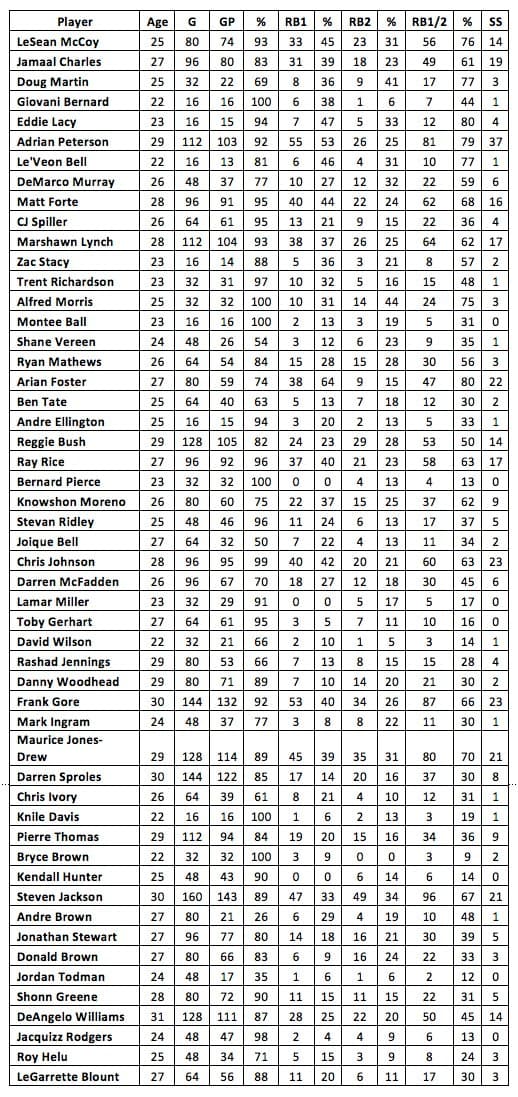
[/am4show]
- 2022 Rookie Class: An Early Look at Kenny Pickett, QB Pittsburgh - January 31, 2022
- Dynasty Fantasy Football Rookie Update: Quez Watkins, WR PHI - July 15, 2020
- Dynasty Fantasy Football Rookie Update: John Hightower, WR PHI - July 7, 2020

































































